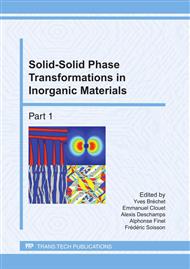p.1112
p.1119
p.1128
p.1134
p.1140
p.1146
p.1156
p.1164
p.1171
3D Cellular Automata Modelling of Solid–state Transformations Relevant in Low–alloy Steel Production
Abstract:
A three-dimensional cellular automata (CA) model is developed for the kinetic and microstructural modelling of the relevant metallurgical mechanisms occurring in the annealing stage of low–alloy steels: recrystallisation, pearlite–to–austenite transformation and ferrite–to–austenite transformation on heating and austenite–to–ferrite transformation on cooling. In this model the austenite–to–ferrite transformation is described by a mixed–mode approach, which implies that the transformation kinetics is controlled by both the interface mobility and the diffusivity of the partitioning elements. This approach also allows incorporation of the ferrite nucleation occurring on structural defects. The developed CA algorithm, in which the transformation rules for the grain boundary and interface cells are controlled by the growth kinetics of the forming phase, allows three-dimensional systems to be treated within relatively short simulation times. The simulated microstructure reproduces quite well the microstructure observed in experimental samples. A good agreement is obtained between the experimental and simulated ferrite recrystallisation and ferrite and austenite transformation kinetics. The present approach also models the development of the carbon concentration profile in the austenite, which is, for instance, essential for subsequent martensite formation.
Info:
Periodical:
Pages:
1140-1145
Citation:
Online since:
June 2011
Authors:
Price:
Сopyright:
© 2011 Trans Tech Publications Ltd. All Rights Reserved
Share:
Citation:


